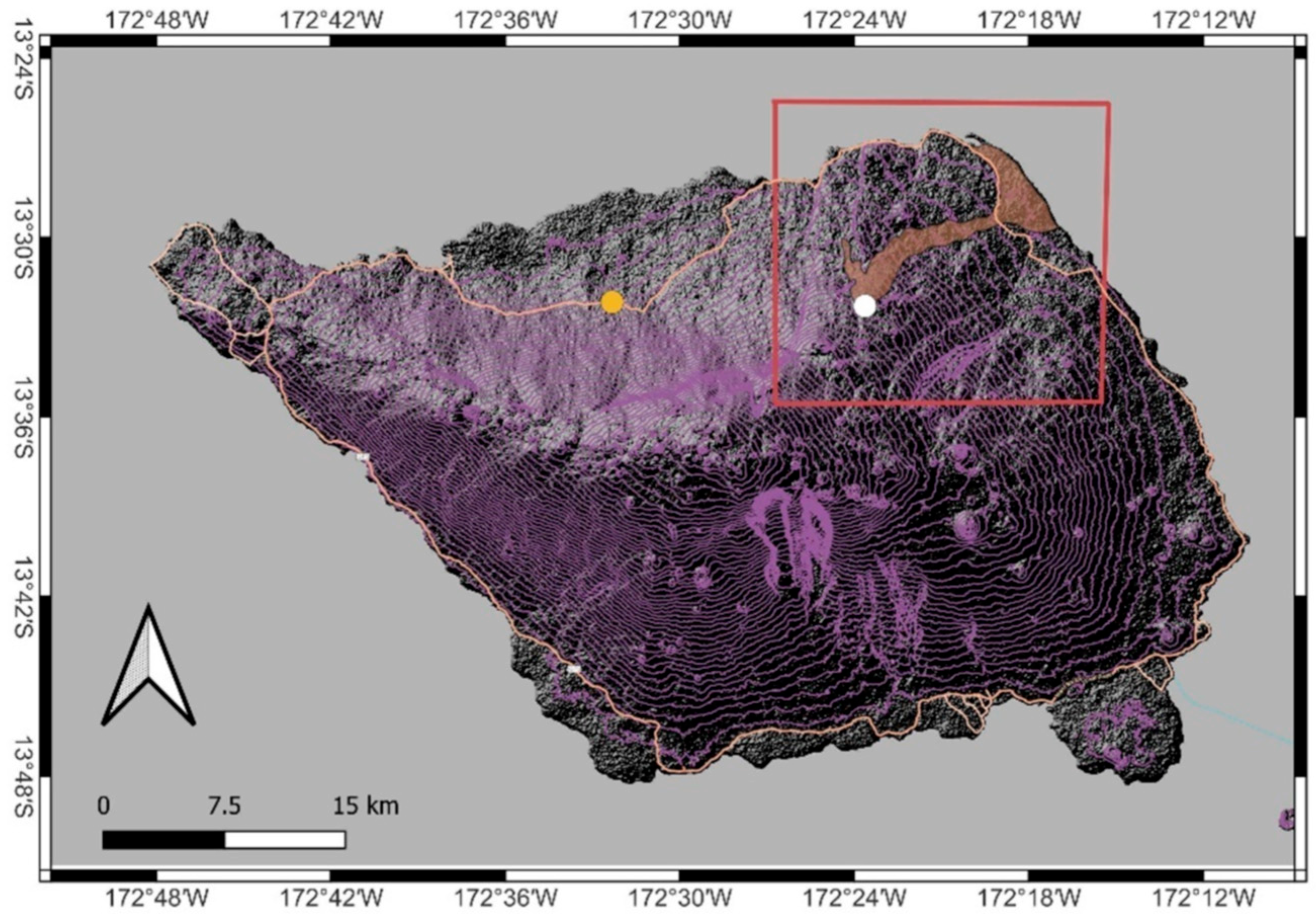Geodiversity and Its Implication for Geoconservation of the Youngest Eruptive Sites of Western Samoa †
Abstract
:1. Introduction
2. Materials and Methods
2.1. Study Area
2.2. Satellite Imagery, Basic Terrain Analysis, Field Observations, and Lava Flow Modelling
3. Results
4. Discussion
5. Conclusions
Funding
Institutional Review Board Statement
Informed Consent Statement
Data Availability Statement
Acknowledgments
Conflicts of Interest
References
- Németh, K.; Cronin, S.J. Volcanic structures and oral traditions of volcanism of Western Samoa (SW Pacific) and their implications for hazard education. J. Volcanol. Geotherm. Res. 2009, 186, 223–237. [Google Scholar] [CrossRef]
- Kear, D. Geological notes on western Samoa. N. Z. J. Geol. Geophys. 1967, 10, 1446–1451. [Google Scholar] [CrossRef]
- Keating, B.H. Geology of the Samoan Islands. In Geology and Offshore Mineral Resources of the Central Pacific Basin; Keating, B.H., Bolton, B.R., Eds.; Circum-Pacific Council for Energy and Mineral Resources, Earth Science Series; Circum-Pacific Council for Energy and Mineral Resources: Houston, TX, USA, 1991; Volume 14, pp. 127–178. [Google Scholar]
- Konter, J.G.; Jackson, M.G. Large volumes of rejuvenated volcanism in Samoa: Evidence supporting a tectonic influence on late-stage volcanism. Geochem. Geophys. Geosyst. 2012, 13, Q07025. [Google Scholar] [CrossRef]
- Koppers, A.A.P.; Russell, J.A.; Roberts, J.; Jackson, M.G.; Konter, J.G.; Wright, D.J.; Staudigel, H.; Hart, S.R. Age systematics of two young en echelon Samoan volcanic trails. Geochem. Geophys. Geosyst. 2011, 12, Q07025. [Google Scholar] [CrossRef]
- McDougall, I. Age of volcanism and its migration in the Samoa Islands. Geol. Mag. 2010, 147, 705–717. [Google Scholar] [CrossRef]
- Jackson, M.G.; Hart, S.R.; Konter, J.G.; Koppers, A.A.P.; Staudigel, H.; Kurz, M.D.; Blusztajn, J.; Sinton, J.M. Samoan hot spot track on a “hot spot highway”: Implications for mantle plumes and a deep Samoan mantle source. Geochem. Geophys. Geosyst. 2010, 11, Q12009. [Google Scholar] [CrossRef]
- Gale, S.J.; Miggins, D.P.; Fepuleai, A. Ar-40/Ar-39 dating of Quaternary volcanic rocks in Samoa. N. Z. J. Geol. Geophys. 2021, 65, 381–388. [Google Scholar] [CrossRef]
- Anderson, T. The Volcano of Matavanu in Savaii. Q. J. Geol. Soc. 1910, 66, 621–639. [Google Scholar] [CrossRef]
- Fepuleai, A.; Németh, K.; Muliaina, T. Geopark impact for the resilience of communities in Samoa, SW Pacific. Geoheritage 2021, 13, 50. [Google Scholar] [CrossRef]
- Németh, K.; Fepuleai, A.; Muliaina, T. Samoa Geopark Project: A strategic plan to promote the volcanic geoheritage of Savai’i Island, Samoa. In Proceedings of the STAR 2017—The Pacific Islands Science, Technology and Resources Conference, Nadi, Fiji, 26–29 June 2017. [Google Scholar] [CrossRef]
- Cronin, S.J.; Bonte-Grapentin, M.; Németh, K. Samoa technical report—Review of volcanic hazard maps for Savai’i and Upolu. EU-SOPAC Proj. Rep. 2006, 59, 1–27. [Google Scholar]
- Jasiewicz, J.; Stepinski, T.F. Geomorphons—A pattern recognition approach to classification and mapping of landforms. Geomorphology 2013, 182, 147–156. [Google Scholar] [CrossRef]
- Mossoux, S.; Saey, M.; Bartolini, S.; Poppe, S.; Canters, F.; Kervyn, M. Q-LAVHA: A flexible GIS plugin to simulate lava flows. Comput. Geosci. 2016, 97, 98–109. [Google Scholar] [CrossRef]
- Prieto-Torrell, C.; Rodriguez-Gonzalez, A.; Aulinas, M.; Fernandez-Turiel, J.L.; Cabrera, M.C.; Criado, C.; Perez-Torrado, F.J. Modelling and simulation of a lava flow affecting a shore platform: A case study of Montana de Aguarijo eruption, El Hierro (Canary Islands, Spain). J. Maps 2021, 17, 502–511. [Google Scholar] [CrossRef]
- Vilches, M.; Ureta, G.; Grosse, P.; Nemeth, K.; Aguilera, F.; Aguilera, M. Effusion rate estimation based on solidified lava flows: Implications for volcanic hazard assessment in the Negros de Aras monogenetic volcanic field, northern Chile. J. Volcanol. Geotherm. Res. 2022, 422, 107454. [Google Scholar] [CrossRef]
- Zakharovskyi, V.; Németh, K. Qualitative-Quantitative Assessment of Geodiversity of Western Samoa (SW Pacific) to Identify Places of Interest for Further Geoconservation, Geoeducation, and Geotourism Development. Geographies 2021, 1, 362–380. [Google Scholar] [CrossRef]
- Zakharovskyi, V.; Németh, K. Scale Influence on Qualitative-Quantitative Geodiversity Assessments for the Geosite Recognition of Western Samoa. Geographies 2022, 2, 476–490. [Google Scholar] [CrossRef]






Disclaimer/Publisher’s Note: The statements, opinions and data contained in all publications are solely those of the individual author(s) and contributor(s) and not of MDPI and/or the editor(s). MDPI and/or the editor(s) disclaim responsibility for any injury to people or property resulting from any ideas, methods, instructions or products referred to in the content. |
© 2022 by the author. Licensee MDPI, Basel, Switzerland. This article is an open access article distributed under the terms and conditions of the Creative Commons Attribution (CC BY) license (https://creativecommons.org/licenses/by/4.0/).
Share and Cite
Németh, K. Geodiversity and Its Implication for Geoconservation of the Youngest Eruptive Sites of Western Samoa. Proceedings 2023, 87, 33. https://doi.org/10.3390/IECG2022-13751
Németh K. Geodiversity and Its Implication for Geoconservation of the Youngest Eruptive Sites of Western Samoa. Proceedings. 2023; 87(1):33. https://doi.org/10.3390/IECG2022-13751
Chicago/Turabian StyleNémeth, Károly. 2023. "Geodiversity and Its Implication for Geoconservation of the Youngest Eruptive Sites of Western Samoa" Proceedings 87, no. 1: 33. https://doi.org/10.3390/IECG2022-13751
APA StyleNémeth, K. (2023). Geodiversity and Its Implication for Geoconservation of the Youngest Eruptive Sites of Western Samoa. Proceedings, 87(1), 33. https://doi.org/10.3390/IECG2022-13751





